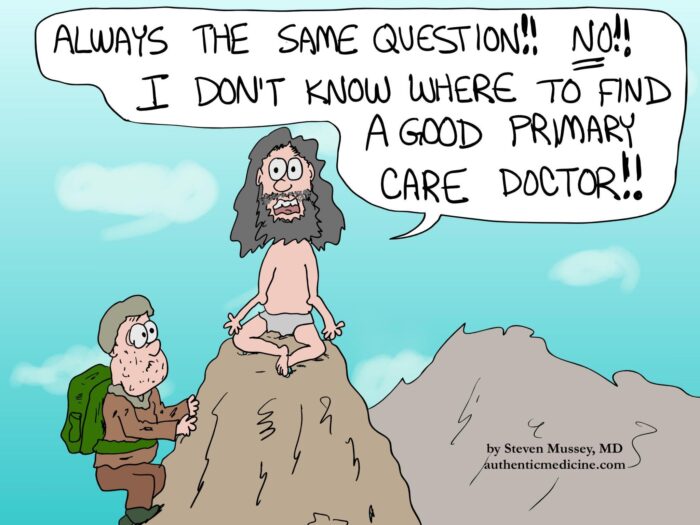Primary Care Doctors: Will they even exist in a few years?

Now, more than ever, it is difficult to find a good Primary Care Doctor.
On the other hand, you can always find an Urgent Care Doctor. You may also find an Urgent Care Clinic that will pretend it can be your total Primary Care solution.
The problems with the Urgent Care option are many: Most of the time, you won’t see a doctor. If you do see a doctor, the doctor is more geared to Urgent Care issues. If you throw something a little odd at the doctor, like a mild increase in the serum creatinine or a drop in the sodium level, they tend to freak out and want you to immediately see an assortment of specialists.
In the old days of Primary Care, studious physicians took pride in working up unusual issues as completely as possible. If a specialist was still necessary, the patient’s medical evaluation was tied up in a neat little package to try and make the specialist’s work as rapid as possible.
Now, if you make any complaint in a medical visit, you are on your way to a new specialist. Soon, you have the classic example of too many cooks (doctors or whatever extenders) trying to manage the case. The complexity increases simply because you now have ten specialists (or their extenders) involved, making their own changes.
Often, you will even have multiple practitioners in the same specialty. Typically, Cardiology monitoring involves both a non-invasive doctor and a rhythm doctor.
Patients see this and they ask the question: Who is a good primary care doctor? I want somebody smart enough to take the ball and carry it.
My answer: I can tell you, but you still won’t be able to get an appointment.
The problem is good primary care doctors fill up quickly. Why is this happening?
- Primary Care as a physician-based field is a vanishing occupation. The Internal Medicine residency is now simply a gateway to sub-specialization.
2. Doctors in Primary Care feel undervalued.
3. Doctors in the field are being replaced by less trained extenders. Often, the doctors themselves hire the extenders to try and see more patients. Often the owner decides extenders are a cheap way to grow the practice for a future profitable sale.
4. As practices grow, they get bought by hospital systems. Patients almost always experience a decline in customer service once this occurs. Then, within a few months to years, the employed doctors leave town.
5. Trying to hire a Primary Care Doctor is astonishingly difficult. They are rarely seen in the wild. If you photograph one, it qualifies for the cover of National Geographic.
6. As a practicing Primary Care Doctor, every drug you order, every test you request, every imaging study you authorize, requires a ridiculous maze of prior authorization, time on hold and arguments with a “Peer Review Specialist.” It is made to create hassle and it does so with great effectiveness.
7. Specialists tend to advise adding an extremely expensive non-formulary drug, dumping the nightmare of prior authorization into the lap of the Primary Care Doctor.
8. In short, it is a field designed for maximum burn-out potential.
Unfortunately, it is also a necessary job. We need good Primary Care Doctors.
But, like the endangered Okapi, they are quickly vanishing!









I see a lot of personalinjury cases.
It is amazing how often I see someone with a car accident to to a ER or UC and see a Nurse Practitioner, who then refers to orthopedics to be seen by an oOthopedic Physician Assistant, converned about numbness so referred to Neurology to be seen by the Newrulogy Nurse Practitioner.
A file a couple inches thick, and the patient has never seen a physician.
This happens in other fields as well. You can be admitted to the hospital and never see a doctor there either. Believe me, I’ve seen it done. And with very bad consequences.
I suspect FP will remain as a specialty. Where are all the med students going to go when they don’t match? There aren’t enough residency slots as there are more graduating med students. Many who don’t want FP. When faced with no match, one has to be resourceful and do something if they want to earn a living.
3 words…..Direct Primary Care…..The Holy Grail for primary care doctors……and it is possible
Should we go back to General Practitioners. Require only 1 year of internal medicine. Compete against the lesser trained NP, etc with less training? Would one and done, encourage more primary care again? The development of the Family Practice Residency was primarily for the argument that specialists with more years of training got paid more, and thus increasing the training would lead to more reimbursement, which did not happen. In addition, it resulted in the abandonment of specialty differential with its resulting own problems.
No, they won’t exist in a few years. It is too hard, no longer satisfying, and doesn’t pay well enough to make up for the aggravation and hard work.
And the patient is often peremptorily referred to a specialist because however difficult it is to get in with a PriCare doc, they will always be able to find a malpractice lawyer.